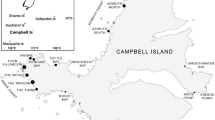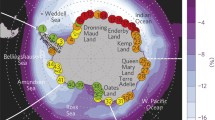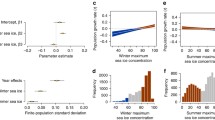Abstract
Overall Adélie penguin population size in Pointe Géologie Archipelago increased between 1984 and 2003 at a rate of 1.77% per year, and averaged 33,726±5,867 pairs. As predicted by the optimum model proposed by Smith et al. (Bioscience 49:393–404, 1999). Adélie penguin population size increased when sea ice extent and concentration (SIE and SIC) decreased six years earlier, indicating that the conditions around reproduction or first years at sea, were determinant. The breeding success averaged 85.2±35.45% and was not related to environmental variables. Adult survival probability varied between years from 0.64 to 0.82. Southern oscillation index (SOI) had a strong negative effect on adult annual survival. Adult survival of Adélie penguins increased during warmer events, especially during winter and spring at the beginning of reproduction. Therefore, we speculate that the rapid decreases in 1988–1991 and 1996 of the breeding population size were related to a decrease in adult mortality. However, adult survival varied little, and could not explain the strong increasing population trend. The sea ice conditions during breeding or during the first year at sea appeared determinant and influenced the population dynamics through cohort effects, probably related to the availability of productive feeding habitats.






Similar content being viewed by others
References
Ainley DG, Clarke ED, Arrigo K, Fraser WR, Kato A, Barton KJ, Wilson PR (2005) Decadal-scale changes in the climate and biota of the Pacific sector of the Southern Ocean, 1950s to the 1990s. Antarct Sci 17:171–182
Ainley DG, Ballard G, Emslie SD, Fraser WR, Wilson PR, Woehler EJ (2003) Adélie Penguins and environmental change. Science 300:429
Ainley DG (2002) The Adélie penguin: bellwether of climate change. Columbia University Press, New York
Ainley DG, DeMaster DP (1980) Survival and mortality in a population of Adélie penguins. Ecology 61:522–530
Anderson DR, Burnham KP (1999) General strategies for the analysis of ringing data. Bird Study 46:261–270
Barbraud C, Weimerskirch H, Guinet C, Jouventin P (2000) Effect of sea-ice extent on adult survival of an Antarctic top predator: the snow petrel Pagodroma nivea. Oecologia 125:483–488
Burnham KP, Anderson DR (1998) Model selection and inference: a practical information-theoretic approach. Springer-Verlag, New York
Burnham KP, Anderson DR (2001) Kullback-Leibler information as a basis for strong inference in ecological studies. Wildlife Res 28:111–119
Choquet R, Reboulet AM, Pradel R, Gimenez O, Lebreton JD (2002) User’s manual for U-CARE. Mimeographed document, CEFE/CNRS, Montpellier
Clobert J, Lebreton JD (1991) Estimation of demographic parameters in bird populations. In: Perrins CM, Lebreton JD, Hirons GJM (eds) Bird population studies. Oxford University Press, Oxford, pp 75–104
Croxall JP, Trathan PN, Murphy EJ (2002) Environmental change and Antarctic seabirds populations. Science 297:1510–1514
Curran MAJ, van Ommen TD, Morgan VI, .Phillips KL, Palmer AS (2003) Ice core evidence for antarctic sea ice decline since the 1950s. Science 302:1203–1206
Davis LS, Harcourt RG, Bradshaw CJA (2001) The winter migration of Adelie penguins breeding in the Ross Sea sector of Antarctica. Polar Biol 24:593–597
Fraser WR, Trivelpiece WZ, Ainley DG, Trivelpiece SG (1992) Increase in Antarctic penguin populations: reduced competition with whales or a loss of sea ice due to environmental warming? Polar Biol 11:525–531
Fyfe JC, Boer GJ, Flato GM (1999) The Arctic and Antarctic oscillations and their project changes under global warming. Geophys Res Lett 26:1601–1604
Gaillard JM, Boutin JM, Delorme D, Van Laere G, Duncan P, Lebreton JD (1997) Early survival in roe deer: causes and consequences of cohort variation in two contrasted populations. Oecologia 112:502–513
Gaillard JM, Yoccoz NG (2003) Temporal variation in survival of mammals: a case of environmental canalization? Ecology 84:3294–3306
Gong D, Wang S (1999) Definition of Antarctic oscillation index. Geophys Res Lett 26:459–462
Houghton JT, Ding Y, Griggs DJ, Noguer M, Van der Linden PJ, Xiasou D (2001) Climate change 2001: the scientific basis, contribution of working group I to the third assessment report of the intergovernmental panel on climate change. Cambridge University Press, Cambridge
Jackson S, Wilson RP (2002) The potential costs of flipper-bands to penguins. Funct Ecol 16:141–148
Jenouvrier S, Weimerskirch H, Barbraud C, Park Y-H., Cazelles B (2005) Evidence of a shift in cyclicity of of Antarctic seabirds dynamics link to climate. Proc Roy Soc 272:887–895
Kwok R, Comiso JC (2002) Southern ocean climate and sea ice anomalies associated with the southern oscillation. Am Meteorol Soc 15:487–501
Lebreton JD, Burnham KP, Clobert J, Anderson DR (1992) Modeling survival and testing biological hypotheses using marked animals: a unified approach with case studies. Ecol Monograph 62:67–118
Liu J, Curry JA, Martinson DG (2004) Interpretation of recent Antarctic sea ice variability. Geophys Res Lett, 31, doi:10.1029/2003GL018732
Liu J, Yuan X, Rind D, Martison DG (2002) Mechanism study of the ENSO and southern high latitude climate teleconnections. Geophys Res Lett 29:24–33
Loeb VJ, Siegel V, Holm-Hansen O, Hewitt R, Fraser W, Trivelpiece SG (1997) Effects of sea-ice extend and krill or salp dominance on the Antarctic food web. Nature 387:897–900
Micol T, Jouventin P (2001) Long-term population trends in seven Antarctic seabirds at Pointe Géologie (Terre Adélie). Human impact compared with environmental change. Polar Biol 24:175–185
Pannekoek J, van Strien AJ, Roby D (2004) TRIM (Trends and Indics for Monitoring Data). Statistics Netherlands, Vooburg, the Netherlands
Park Y-H, Roquet F, Vivier F (2004) Quasi-stationary ENSO wave signals versus the Antarctic circumpolar wave scenario. Geophys Res Lett 31
Prevost J, Sapin-Jaloustre J (1965) Ecologie des manchots antarctiques. In: Junk W (ed) Biogeography and ecology in Antarctica. pp 551–468
Saether BE, Bakke O (2000) Avian life history variation and contribution of demographic trait to the population growth rate. Ecology 81:642–653
Schemper M (1990) The explained variation in proportional hazards regression. Biometrika 77:216–218
Smith RC, Ainley D, Baker K, Domack E, Emslie S, Fraser B, Kenett J, Leventer Aeal (1999) Marine ecosystem sensitivity to climate change. Bioscience 49:393–404
Stenseth NC, Mysterud A, Ottersen G, Hurell JW, Chan KS, Lima M (2002) Ecological effects of climate fluctuations. Science 297:1292–1295
Stenseth NC, Ottersen G, Hurell JW, Mysterud A, Lima M, Chan KS, Yoccoz NG, Adlandsvik B (2003) Studying climate effects on ecology through the use of climate indices, the North Atlantic Oscillation, El Nino Southern Oscillation and beyond. The Royal Society. Published online
Stenseth NC, Ottersen G, Hurell JW, Belgrano A (2004) Marine ecosystems and climate variation. The North Atlantic: a comparative perspective. Oxford University Press, Oxford
Tynan CT (1998) Ecological importance of the southern boundary of the Antarctic circumpolar current. Nature 392:708–710
Vaughan DG, Marshall GJ, Connolley WM, King JC, Mulvaney R (2001) Devil in the detail. Science 293:1777–1779
White GC, Burnham KP (1999) Program MARK: survival estimation from populations of marked animals. Bird Study 46(suppl):120–138
Wienecke BC, Lawless R, Rodary D, Bost CA, Thomson R, Pauly T, Robertson G, Kerry KR, Le Maho Y (2000) Adelie penguin froraging behaviour and krill abundance along the Wilkes and Adelie land coasts, Antarctica. Deep-Sea Res 47:2573–2587
Wilson PR, Ainley DG, Nur N, Jacobs SS, Barton KJ, Ballard JC, Comiso JC (2001) Adélie penguin population change in the pacific sector of Antarctica: relation to sea-ice extend and the Antarctic circumpolar current. Mar Ecol Prog Ser 213:301
Yuan X, Martinson DG (2001) The Antarctic dipole and its predictability. Geophys Res Lett 28:3609–3612
Acknowledgements
We greatly acknowledge all the wintering fieldworkers involved in the long-term monitoring of Adélie penguins in Terre Adélie since 1984, Dominique Besson for her constant support and help in the management of the database and Thierry Micol for building the Adélie penguin database. We would particularly like to thank the fieldworkers Armelle Lagarde, Rodolphe Bernard, and Karine Delord. We thank David Ainley for his in depth comments and two anonymous referees. This long-term study was supported by Expéditions Polaires Françaises, by Institut Paul Emile Victor (Programme IPEV n°109), and by Terres Australes et Antarctiques Françaises.
Author information
Authors and Affiliations
Corresponding author
Rights and permissions
About this article
Cite this article
Jenouvrier, S., Barbraud, C. & Weimerskirch, H. Sea ice affects the population dynamics of Adélie penguins in Terre Adélie. Polar Biol 29, 413–423 (2006). https://doi.org/10.1007/s00300-005-0073-6
Received:
Revised:
Accepted:
Published:
Issue Date:
DOI: https://doi.org/10.1007/s00300-005-0073-6




